Solkatt är ett nytt svenskt företag som designar och producerar solsäkra unisexkläder för barn. Det som särskiljer Solkatts kläder från övriga märken på marknaden är dess breda användningsområde. Solkatts plagg är designade för att skydda barnet i alla situationer dit solens strålar når – på lantstället, i stan och inte minst på havet.
 Till Solkatts mest nöjda kunder hör båtfolk. De tunna men skylande kläderna skyddar barnet från topp till tå, samtidigt som de är rymliga och sköna att bära.
Till Solkatts mest nöjda kunder hör båtfolk. De tunna men skylande kläderna skyddar barnet från topp till tå, samtidigt som de är rymliga och sköna att bära.
– Solkatts kläder underlättar enormt för oss då vi seglar. Tidigare fick vi flera gånger om dagen smörja våra killar med solkräm, nu är barnen skyddade så snart kläderna är på, otroligt smidigt. Ett annat plus är det sköna tyget som är lätt att tvätta och som torkar rekordsnabbt på relingen, säger Björn Forslund, tvåfaldig svensk världsmästare i segling och van familjeseglare.
Solkatts kläder erbjuder det bästa dokumenterade skyddet mot UV-strålning som finns, 50+. Textilen består av 100 procent nylon och stänger ute 97 procent av solens farliga strålar samtidigt som den andas och är skön mot huden.
Länk: www.solkatt.nu
Till skillnad från Sverige så har Norge ett båtregister. Finanserna verkar dock inte vara så bra utan nu ska Norges frivilliga båtregister, som administreras av det norska Redningsselskapet (motsvarigheten till Sjöräddningssällskapet i Sverige), öka sin årliga medlemsavgift med 75%.
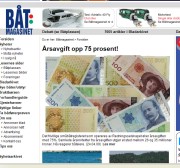 När registret drogs igång sa de ansvariga att det skulle vara enkelt och effektivt, enligt tidningen Båtmagasinets hemsida.
När registret drogs igång sa de ansvariga att det skulle vara enkelt och effektivt, enligt tidningen Båtmagasinets hemsida.
Registret drar redan in mellan 26 och 35 miljoner norska kr per år och därmed kommer misstankarna om att registerverksamheten i själva verket används som ekonomiskt stöd för Redningsselskapets drift. En ökning med 75% skulle därmed kunna få ekonomin att blomstra eller så har de administrativa avgifterna skjutit i höjden.
Osäkerheten verkar också vara stor om hur många båtar som verkligen är anslutna till registret. Sällskapet har uttryckt att det handlar om 250 000 båtar medan andra uppgifter säger 150 000.
När det norska registret startades 2006 var medlemsavgiften 100 kr. Nu har den alltså ökat till 175 kr.
Länk: www.batmagasinet.no
Sir Robin Knox-Johnston celebrerar i år 40-årsjubileet av sin historiska solosegling med hjälp av storcirkelnavigation. Det var 22 april 1969 som Sir Robin Knox-Johnston, en av världens mest kända ensamseglare, blev historisk som den förste som seglade ensam non-stop jorden runt.
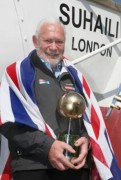 Sir Robin var den ende brittiske deltagaren i Sunday Times Golden Globe yacht race som tog sig i mål efter 312 till sjöss. En bedrift som få andra har upprepat sedan dess.
Sir Robin var den ende brittiske deltagaren i Sunday Times Golden Globe yacht race som tog sig i mål efter 312 till sjöss. En bedrift som få andra har upprepat sedan dess.
Sir Robin har dock gjort om sin egen bravad. Senast för två år sedan, då han vid 68 årsålder deltog i VELUX 5 OCEANS. Nu är det dock slut med sådana äventyr och Sir Robin firade sitt 40-årsjubileum i centrala London genom att segla uppför Themsen till Tower Bridge med sin originalbåt från 1969, Suhaili.
Idag är Sir Robin ordförande för Clipper Ventures Plc, ett företag som håller på med marina event. Han grundade själv företaget 1995 och är nu med och arrangerar VELUX 5 OCEANS och Clipper Round the World Yacht Race.
Knox-Johnston fick sällskap i London i St Katharine Docks av Hull & Humber, en av de tio identiska 68-fots racingbåtar som ska delta i nästa Clipper Race, det enda globala eventet för ickeprofessionella seglare. Ombord blev han välkomnad av åtta av de 18 brittiska seglare som har seglat ensamma jorden runt enligt storcirkelmetoden, inklusive den kvinnliga skepparen Dee Caffari och Steve White, som båda nyligen avslutade Vendée Globe race.
Länk: www.clipperroundtheworld.com
Länk: www.velux5oceans.com
Ericsson Racing Team ligger etta och trea med Puma på andra plats när det återstår cirka 450 Nm av Leg 6 av Volvo Ocean Race som går i mål i Boston. Ericsson 4, med skepparen och femfaldige olympiamästaren Torben Grael, kom upp i ledningen på torsdagskvällen efteratt ha seglat i stealth mode. Det innebär att båtarna kan segla utom synhåll för de övrigadeltagarna i tolv timmar. För Ericsson 4 var det ett riktigt drag.
Ericsson 3, med veteranen Magnus “Mange” Olsson somskeppare, seglade också i stealth mode och kunde ta sig upp i täten och låg länge tvåa, men på fredagskvällen kom Puma upp på andra plats och låg vid 18-tiden svensk tid 27 Nm efter Ericsson 4.
Detta innebär en stor förändring för hela fältet. Så sent som i söndags ledde Telefónica Blue deltävlingen med 105 Nm.
“Vi hämtade upp Telefónica Blues försprång bra och vi har ju tampats med henne om förstaplatsen, säger Grael.
“Men trots att vi nu ligger etta är det fortfarande en öppen tävling mellan oss, Ericsson 3 och Puma.”
Förhållandena ombord är minst sagt omväxlande. Båtarna korsade en väderfront igår, vilket innebar snabba förändringar och ökande vind. När sedan fältet seglade in i Golfströmmen blev sjön grov.
“En andra kallfront drog förbi fältet med båtar samtidigt som de kom in i Golfströmmen, säger meteorologen Chris Bedford.
“Vindarna har skiftat till nordväst – rakt för ifrån – och även ökat till 20-30 knop och kulingstyrka ibland. Dettaskapar ganska stora vågor, något som båtarna gärna undviker.
“Vi försöker byta till ett mindre storsegel och taytterligare ett rev. Alla får hjälpa till med arbetet på däck, säger Gustav Morin, mediaman på Ericsson 3.
“Väderförhållandena har snabbt blivit mycket sämre. Båten slår emot sjön och hela båten rör sig snabbt från sida till sida samtidigt som rorsman måste hålla en bra kurs. Det är minst sagt en knepig situation.
Medan Ericsson 4 seglade i stealth mode upptäckte besättningen även att båtens vattenmakare, som gör färskvatten, hade gått sönder.
“Dave Endean (onboard boat captain) var snabb med att hitta felet och upptäckte att vi hade tagit sönder en koppling till ett vattenmembran genom vilket saltvattnet spolas i högt tryck för att få fram färskvatten, säger Guy Salter, Ericsson 3 mediaman.
VOLVO OCEAN RACE LEG 6 LEADERBOARD
(At 1259 GMT, Apr. 24, 2009)
1. Ericsson 4, 487 nautical miles to finish
2. Ericsson 3, +36 NM
3. Telefónica Blue, +40
4. Puma, +62 NM
5. Delta Lloyd, +116 NM
6. Green Dragon, +125 NM
7. Telefónica Black, +131 NM
Länk: www.volvooceanrace.org
Genom ett beslut i övervakningskommittén för Europeiska fiskerifonden i Sverige kommer ytterligare 150 miljoner kronor att göras tillgängliga för skrotning av fiskefartyg med hjälp av offentligt stöd.
Fiskeriverket har nyligen beräknat att 40 procent av torskfiskeflottan i Västerhavet bör skrotas för att ge förutsättningar för ett hållbart och lönsamt fiske. Fiskeriverket hade därför lämnat ett förslag till övervakningskommittén om en ändring i programbudgeten.
– Vi gör en prioritering genom att överföra pengar från andra stödområden till skrotning, säger Bengt Strömblom vid Fiskeriverket.
Beslut i samförstånd
Övervakningskommittén är tillsatt av regeringen för att kontrollera att EU-stöden från Europeiska fiskerifonden används effektivt. Kommittén leds av
Jordbruksdepartementet och samlar representanter från berörda näringar som yrkesfisket, vattenbruket och beredningsindustrin samt intresseorganisationer som Sportfiskarna och Världsnaturfonden. Även ledamöter från Fiskeriverket, Jordbruksverket, Naturvårdsverket med flera myndigheter ingår i kommittén, som fattar beslut i konsensus.
– Det är glädjande att vi nu har möjlighet att genomföra den planerade skrotningskampanjen i Västerhavet, som är en nödvändig åtgärd för att anpassa flottkapaciteten efter fiskresursen. Därmed kan vi bidra till att förbättra situationen för de fiskare som i dag är i en svår situation, så att branschen kan återfå sin framtidstro. Beslutet lägger grunden för att vi ska kunna utveckla ett långsiktigt hållbart fiske, säger Fiskeriverkets generaldirektör Axel Wenblad.
Högt söktryck
Det finns ett högt söktryck till stödprogrammet och i dagsläget har knappt 75 miljoner kronor i EU-medel beviljats till andra åtgärder än skrotning. Efter omföringen finns ett fortsatt beslutsutrymme på 230 miljoner kronor för olika typer av projekt, till exempel utsättningar av hotade arter som ål och andra projekt med miljöfokus, och för stöd till investeringar i vattenbruk och beredning.
Till detta kommer även den nationella medfinansieringen som varierar mellan de olika insatserna. Regeringen har genom den havspolitiska propositionen nyligen ökat medfinansieringen till programmet, med fokus på olika miljöförbättrande åtgärder.
Briggen Tre Kronor är nu ute på årets första seglingar. För första gången i modern tid seglar en brigg i Mälaren. Det är briggen Tre Kronor af Stockholm som börjar sin säsong med en resa till Södertälje, Mariefred, Västerås och Köping.
Seglingar för näringsliv och allmänhet
Under besöken blir det öppet skepp med olika aktiviteter ombord och på kajen. För den som någon gång drömt om att få segla ett äkta segelfartyg så är det här chansen. Vid varje besök anordnas särskilda seglingar för allmänheten där alla som vill är välkomna att prova på. Aktuella tider finns på www.briggentrekronor.se
Det anordnas även särskilda företagsseglingar där små och stora företag har möjlighet att bjuda ta med kunder och anställda på en segling. Målet med företagsseglingarna är bland annat att underhålla och utveckla relationen med sina viktigaste kunder samt underlätta för företagarna att knyta kontakter med varandra.
Ett genuint bygge
Tre Kronor af Stockholm byggdes på Skeppsholmen i Stockholm av några av Sveriges skickligaste hantverkare. Konstruktionen är densamma som på 1800-talet och hon seglas helt och hållet för hand.
Sjösättningen skedde den 27 augusti 2005 med Kronprinsessan Victoria som gudmor. Förra året gjorde hon sin första stora segling runt Östersjön och besökte Helsingfors, Tallinn och Riga. Efter besöket i Mälaren kommer hon i år att delta i The Tall Ships´ Races.
En ambassadör för östersjöregionen
Briggen Tre Kronor seglar för Östersjön vilket innebär att vi arbetar tillsammans med ungdomar, myndigheter, näringsliv och intresseorganisationer för att Östersjön ska bli friskare och att länderna runt Östersjön ska växa tillsammans.
Länk: www.briggentrekronor.se
Ericsson 4 kommer allt närmare Telefonica Blue, som leder den pågående etappen av Volvo Ocean Race. Ericsson 4 ligger nu endast 10 Nm akter om den spanska båten medan Ericsson 3 ligger 25 Nm efter. På fjärde plats ligger Puma, 36 Nm efter. Nu återstår mindre än 1 000 Nm till målet i Boston. Med lika goda förutsättningar som de senaste dagarna så kommer Ericssons båda båtar att få en tuff kamp med Telefonica Blue om segern.
Här är den senaste pressreleasen från Race Office:
PUMA Leg Six Day 11 QFB: received 21.04.09 1931 GMT
Posted: 22 Apr 2009 11:31 AM PDT
One of the fun parts of this race is learning about each other’s lives in ways that you never could otherwise. You live in close quarters for nine months. Eleven guys crammed into, quite literally, a shoe. Here are just a few simple ones:
For example, I know that Erle Williams takes his job with the J Boat ‘Ranger’ so personally that he could feel the collision that they had with Velsheda yesterday at the Antigua Classic Regatta from here.
I know that Shannon Falcone likes to night time kiteboard back in Antigua. Sounds like a tough life doesn’t it?
I know that Casey Smith is possessed about dune buggy-style cars and has put together his own engine in his garage and is searching desperately for a chassis to go with it to drive around Newport in style.
Justin Ferris went home over the last break and went sailing. Think about that for a minute. Thing is, he went sailing on his new 30′ version of a Volvo 70, that is painted purple.
Andrew Cape gets IT jobs on the side when he isn’t sailing.
Sidney Gavignet has a mural of a Phoenix painted on his back.
Rob Salthouse can fix just about anything on a boat – whatever kind of boat it is.
Bob Greenhalgh is passionate about deep sea fishing and puts a photo of himself with some big fish up as a screensaver on all our computers.
Ricky Deppe has a very interesting sense of what makes a movie good and what doesn’t.
And Michi Mueller – the quiet one, has a competitive a streak as anyone I have met. First one to the nav station every three hours to see how we are doing – won’t talk about it though. Oh yeah, and his new born daughter will be meeting him on the dock in Boston – a very special moment that will be.
They are a bunch of good guys that will be part of this ‘Monster Club’ for the rest of our days.
As for the race? Oh yes, we are heading northwest still in search of a little more wind. The boats to the west of us have capitalised on a bit more breeze in the past 24 hours. We have to do something about that soon. We think we’ll be able to claim the miles back soon but time will only tell. The drag race continues.
Kenny Read – skipper
Leg Six Day 12 Daily Story: Tense Time For Telefónica Blue
Posted: 22 Apr 2009 08:03 AM PDT
The bleeding should have stopped by now. Telefónica Blue should be in good breeze and her margin increased to a safer distance from the hounds that are on her tail. She should have been looking ahead to a clear win in Boston.
However, nothing has gone according to plan. The Weather Gods are not playing fairly and Ericsson 4 is continuing to close. She has the bit between her teeth with Ericsson 3 equally focussed, but four miles behind. The gap is now a worrying 22 miles and there is only 1273 nm of runway left for Telefónica Blue to the finish in Boston.
In a radio interview today, the skipper of Ericsson 4, overall race leader, Torben Grael, said, “Slowly but surely, we are eating into Telefónica Blue’s lead, and the race is now much more open. At the same time, we are having a good fight with Ericsson 3 and PUMA for second place. We are always within five to 10 miles of each other. We are all giving it our utmost to try to get that second spot. The position we have in the fleet obviously influences the mood on board, but it’s part of ocean sailing to concentrate at all times to do a good job and to have patience when things don’t go so well. “
Ahead, the weather is due to change. According to race meteorologist Jennifer Lilly, low pressure has been moving slowly over the east coat this week, leaving wet and cool conditions for the shore teams in Boston. This same low will move off the coast tomorrow and will pass over the fleet sometime on Friday giving gusty winds and squalls. If the fleet is near the Gulf Stream, it will cause rapidly building seas.
According to Grael, this will mean a tack onto port, the first time since the fleet passed Cabo Frio at the start of the leg near Rio de Janeiro. “The poor boat has been on starboard tack the whole time! We will then have different wind, which will bring us some new opportunities.”
Speeds are high across the whole fleet, which routing software is predicting will finish in Boston on Sunday afternoon. Although the two Ericsson boats are still sailing a knot faster and recorded a 24-hour run of 419 against Telefónica Blue’s 410nm, the blue boat is still holding her own against the rest of the fleet.
“This race is hard. The boats are so similar in speed, between 5-10 miles of separation since Fernando de Noronha with two other boats, and that is very hard work,” concluded Grael.
Scoring Gate Results Fernando de Noronha
1. Telefónica Blue 19:58:56 GMT 16.04.09 4 Points
2. Ericsson 4 22:55:36 GMT 16.04.09 3.5 Points
3. Delta Lloyd 23:28:32 GMT 16.04.09 3 Points
4. Puma 23:29:31 GMT 16.04.09 2.5 Points
5. Telefónica Black 23:42:20 GMT 16.04.09 2 Points
6. Ericsson 3 00:14:28 GMT 17.04.09 1.5 Points
7. Green Dragon 01:27:26 GMT 17.04.09 1 Point
Leg Six Day 12: 1300 GMT Volvo Ocean Race Positions
(boat name/country/skipper/nationality/distance to finish)
1. Telefónica Blue ESP (Bouwe Bekking/NED) DTF 1,273 nm
2. Ericsson 4 SWE (Torben Grael/BRA) +22nm
3. Ericsson 3 SWE (Magnus Olsson/SWE) +26nm
4. PUMA Racing Team USA (Ken Read/USA) +42 nm
5. Telefónica Black ESP (Fernando Echávarri/ESP) +65nm
6. Delta Lloyd IRL (Roberto Bermúdez/ESP) +70 nm
7. Green Dragon IRL/CHN (Ian Walker/GBR) +116 nm
8. Team Russia RUS (Andreas Hanakamp/AUT) DNS
Länk: www.volvooceanrace.org
Den tyska tillverkaren HanseYachts AG, som äger och tillverkar båtmärkena Hanse, Moody och Fjord, tar över rollen som importör till Sverige och Norge. Därmed får båtmärkena en bättre förutsättning för att växa under en tid när återförsäljarna inte växer i samma takt som producenterna och förändringarna är stora på båtmarknaden.
Nyheten innebär att det bildas en ny organisation för försäljningen i Sverige och Norge. Hittills har import och försäljning i Sverige för Hanse, Moody och Fjord skötts av Bryggan i Väst med huvudkontor i Marstrand.
Nu tas den rollen alltså över av den tyska fabrikens nya svensk-norska organisation, där Per Witte från Bryggan i Väst blir VD.
– Arbetet med en förändring har pågått en längre tid, säger Per Witte.
– Det här är en nödvändig och positiv utveckling för oss. När marknaden förändras så mycket som sker för tillfället får vi återförsäljare svårt att hantera lager i takt med fabrikens introduktion av nya modeller.
I Norge koncentreras marknadsaktiviteterna i den nya organisationen till Fjord AS i Vettre. Nelson Marine AS blir distributör för Hanse på den norska västkusten.
Den tyska fabriken säger i sin kommentar att förändringar ger dem möjlighet att koncentrera mer på sin kärnverksamhet och att komma närmare slutkunderna.
Länk: www.hanseyachts.com
Värmländska Strand-Craft har nu sjösatt sitt senaste projekt. Det är företagets nya lyxbåt, Primadonna 40, som efter ett och ett halvt års hårt arbete har sjösatts för första gången. – Det här är ett lokalt hantverk som attraherar en målgrupp som knappast påverkas av lågkonjunkturen, säger Kurt Strand, VD på Strand-Craft.
9 Mkr kostar den nya unika lyxbåten från Strand-Craft. Konstruktionen bygger på högteknologiska funktioner med det senaste och mest påkostade inom båtbranschen. Vad sägs till exempel om ett styrsystem som navigeras genom en datastyrd joystick, air condition, elektroniska fönsterhissar och möjligheten att genom ett knapptryck förvandla båten från öppen till stängd på några sekunder? Dessutom drar den 25 % mindre bränsle än liknande båtar. Ingenting har lämnats åt slumpen för Primadonna 40.
Värmländska Strand-Craft har blivit världsberömda för sin unika design som kombinerar retrostil med högteknologiska och toppmoderna funktioner. Primadonna 40 är den senaste båten från företaget och intresset har varit stort, framförallt från ekonomiskt oberoende kunder i Mellanöstern, som vill ha mångmiljonbåtarna från Strand-Craft som lyxjollar till sina yachter. I dagsläget förs förhandlingar gällande en beställning av ett hundratal nya båtar. Under produktionen av den senaste båten har ett tiotal lokala underleverantörer involverats.
Nu ska vissa finjusteringar göras av Primadonnan innan den levereras till kund. Men att Kurt Strand skulle luta sig tillbaka och njuta av framgången är det knappast tal om.
– Vi har redan börjat tillverkningen av nästa båt och även den kommer givetvis att bygga på unik retrodesign och högteknologiska funktioner. Det går inte att finna liknande produktioner i världen och därför ser jag mycket ljust på Strand-Crafts framtid, avslutar Kurt Strand.
Länk: www.strand-craft.com
Promarine Group i Stockholm är ny svensk importör av Salona segelbåtar från Kroatien. Efter framgångar i Kontinental- och Sydeuropa ska Salona Yachts fokusera mot Nordeuropa, där Sverige utgör en nyckelmarknad.
– Vi ser mycket fram emot att få representera varumärket där vår erfarenhet och kunskap kommer att komma till godo för att skapa en trygg och långsiktig ägarglädje. Salona Yachts har med sin erkända seglingskänsla, starka konstruktioner, komfort och kvalitet blivit prisbelönta både på och utanför regattor och på båda sidor av Atlanten, säger Johan Wallin på Promarine Group.
Båtarna byggs i Solin i Kroatien. Samtliga modeller är designade av de berömda J & J Design. Båtarna utvecklas och byggs under kontroll och certifiering av Germanischer Lloyd och samtliga modeller uppfyller CE klass A Ocean.
Salona 42 (bilden) är en ”High-Performance-Cruiser”. Hon är designad för seglare med höga krav. Mått 12,8×3,82 m, vikt 7 450 kg. Pris 2,3 Mkr.
Länk: www.salonayachts.com
Efter nästan ett år av intensiv byggverksamhet är Stenungsbadens omfattande om- och tillbyggnader klara, med nya spa- och wellnessanläggningen Bluewater Sports & Health Club som huvudnummer. Annorlunda är bara förnamnet – något liknande finns knappast att skåda på denna sidan av Atlanten. Nysatsningen firas med öppet hus och festlig Spring Regatta under Valborgshelgen.
Stenungsbaden har under det gångna året satsat stora summor på att fräscha upp hela anläggningen. Den enskilt största investeringen är den efterlängtade spa-anläggningen, Bluewater Sports & Health Club, som innebär kraftigt framflyttade positioner för hela anläggningen.
– Den som väntar sig en traditionell spaanläggning med fokus på ro och vila kommer knappast att känna igen sig. Med Bluewater ville vi skapa en betydligt mer fartfylld och saltstänkt wellnessmiljö med mycket hemma-hos-känsla och utrymme för alla slags njutningar och rejäla energikickar, berättar Fredrik Janson, VD på Stenungsbaden Yacht Club.
En bärande del i Bluewaterkonceptet är den marina Newport-stilen som gör sig påmind på såväl in- som utsidan. Resultatet är en exklusiv men ändå avslappnad miljö med en doft av roddarnas klubbhus vid Yale eller Harvard runt förra sekelskiftet. Vitmålade paneler och cederträ blandas med ett välutrus-tat gym, varma källor och bubbelpooler med både ljud och ljuseffekter – och förstås en härlig utsikt över Hakefjorden.
Bluewaterkonceptet innebär också en satsning på flera unika behandlingar, en floatingtank och en Quick Fix Bar för den som vill fräscha upp sig inför kvällens nöjen.
– Vi har medvetet valt en västkustsk profil med mycket salt och tång i olika former. Som första spaanläggning i Sverige kan vi också erbjuda exklusiva oxygenbehandlingar, berättar Elina Pöyliö, wellnesschef på Stenungsbaden Yacht Club.
Nybygget med sina pooler, terrasserade trädäck, barer, behandlings- och träningsrum – och t o m en egen volleybollstrand – innebär en investering på ca 60 miljoner kronor, men Fredrik Janson känner tillförsikt trots konjunkturläget:
– Vår satsning på ett tydligt koncept med seglingssporten som grund inleddes med vår prisbelönta konferensvilla J C Stevens. Bluewater blir en naturlig förlängning av konceptet, som nu blir ännu starkare. Jag skulle varit mer orolig om vi inte gjort den här satsningen. De anläggningar som kommer att klara lågkonjunkturen är de som kan erbjuda upplevelser utöver det vanliga, och det målet når vi nu med råge. Jag är övertygad om att Bluewater kommer att locka helt nya kundgrupper och ge hela anläggningen ett lyft. Till Bluewater kommer man för att ha kul, säger Fredrik och hälsar alla välkomna på Öppet hus den 1 maj.
Bilden:
Kappsegling med CB66.
Länk: www.stenungsbaden.se
I sommar är det åter dags för världens bästa kapseglare att mötas på svenska vatten. Arenan blir som vanligt Match Cup Sweden, som seglas i Marstrand 29 juni-5 juli. I år fyller VM-seglingarna i Match Cup Sweden 15 år. De seglas på väldigt publikvänliga banor, som tillåter alla intresserade att på nära håll se de spännande seglingarna.
Match Cup Sweden i Marstrand 2009 seglas den 29 juni-5 juli. VM-seglingarna är ett årligen återkommande evenemang i världsklass, en riktig publikfest med en unik tävlingsarena som lockar över 100 000 åskådare.
Match Cup Sweden bjuder på en vecka fylld med roliga aktiviteter och underhållning för hela familjen, restauranger och nattliv i toppklass, livesändningar i TV, en mötesplats för svenskt näringsliv samt naturligtvis världens bästa seglare som gör upp om världsmästerskapet i Matchracing!
Länk: www.matchcupsweden.com
Aqualiv AB och bolaget Safe at Sea AB som tillverkar och säljer Rescuerunner på nationell och internationell basis har ingått ett avtal som ger Safe at Sea försäljningsrätten av NavEye mot internationell sjöräddningsverksamhet.
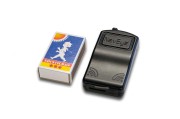 Genom NavEye kan man alltid få Rescuerunnerns exakta position på ett enkelt och kostnadseffektivt sätt. NavEye kan framförallt användas för att säkra förarens position men också som ett alternativ till dyrare positioneringssystem för Rescuerunnerenheten.
Genom NavEye kan man alltid få Rescuerunnerns exakta position på ett enkelt och kostnadseffektivt sätt. NavEye kan framförallt användas för att säkra förarens position men också som ett alternativ till dyrare positioneringssystem för Rescuerunnerenheten.
– Det som gör NavEye intressant för oss är den trygghet och extra säkerhet som vi nu kan erbjuda våra kunder inom sjöräddningsverksamheter, säger Kaj Lehtovaara vd Safe at Sea. NavEyes utformning gör det möjligt att placera enheten på föraren och därmed kunna följa honom. Idag kan man bara följa räddningsenhetens position, inte sjöräddaren tillägger Kaj Lehtovaara.
– Jag ser en stor potential för våra produkter i den kommersiella sjöfarten och inom den sjöräddningsverksamhet som Safe at Sea framgångsrikt är verksamma inom säger Mattias Malmgren, vd Aqualiv AB .
Länk: www.aqualiv.com
Ericssons båda båtar rycker allt närmare ledaren Telefonica Blue i Volvo Ocean Race. Men det går långsamt i de karibiska områden där flottan med sju båtar nu befinner sig. Telefonica Blue leder nu bara med drygt 20 Nm, jämfört med 100 Nm för ett par dagar sedan. Ericsson 4 ligger tvåa och Ericsson 3 på tredje plats.
Fortfarande är det Puma med Ken Read som skeppare som ligger på fjärde plats. Alla båtar i toppen bevakar alltså sina placeringar väldigt noga och det gäller att vara smartast för att gå segrande ur den här nervslitande kampen.
Den enda båt som verkar avhängd för tillfället är Green Dragon, som ligger cirka 100 Nm efter ledaren.
Det återstår nu 1 400 Nm till etappmålet i Boston.
Här är den senaste pressreleasen från Race Office:
Ericsson 4 Leg Six Day 11 QFB: 21.04.09 1504 GMT
Posted: 21 Apr 2009 07:04 AM PDT
It’s another really nice day on Ericsson 4 – the sun is out and the sea is flat – the only issue is the soft spots in the wind from the sucking clouds.
We had a good run last night and are certainly keeping it exciting for ourselves onboard with the battle between Ericsson 3, PUMA and ourselves continuing.
This morning we spotted our sistership on the horizon and have been living the bearing gains and losses ever since.
I’m really looking forward to Boston as in the absence of a stop in NZ I count the city as my home – my wife is a true Massachusetts princess and we have shared many great times in town, so its bound to be a great time catching up with my family and many friends in the area.
I’m also hoping to catch the Red Sox and Celtics whilst in town plus feasting on lobster and shrimp.
The next few days will probably drag on a little but wind is due and there is a chance of a bumpy ride in – but this will make the arrival even better, especially if we can drag Telefónica Blue into the fight and come out on top.
Dave Endean – pitman
Leg Six Day 11 Daily Story: Sailing Caribbean Style
Posted: 21 Apr 2009 06:41 AM PDT
It’s hell for Telefónica Blue today as they see their triple-figure lead whittled down to a miserable 30nm, but it’s heaven for the chasing pack who are still romping along and enjoying the sailing, Caribbean style. But, the time will come when they too sail into the lighter conditions that Telefónica Blue is currently experiencing.
“We have been on the receiving end now for roughly 36 hours, losing mile after mile, which is part of the game. I don’t think it will stop for at least another 20 hours, as then, finally, the others will hit the wall as well,” explained the blue boat’s skipper, Bouwe Bekking.
Telefónica Blue is now on the same latitude as the Caribbean Island of St Martin, and ‘Caribbean sailing’ is what today is all about.
“No more goggles, helmets and full foul weather gear, just Caribbean style shorts and t-shirts,” says Wouter Verbraak, Delta Lloyd’s navigator. “Add a barbeque on the back, a nice chilled bottle of white wine and some fresh yellow fin tuna and we could be cruising along just nicely,” he says.
The reality is that there no time to attend to the barbeque, no hands free to hold their plates and glasses of wine, and the heel of the boat would have things sliding through the cockpit in no time. “It would be a big mess,” says Wouter.
For Shannon Falcone on PUMA, the Caribbean Island of Antigua is his home and he chose this morning to celebrate the passing of the island by offering a drop of Rum to the five crew on deck at the time.
“Do some research into the long relationship between sailors and Rum, especially here in the Caribbean,” says PUMA’s MCM Rick Deppe, who added that the one mini-bar sized bottle shared among five probably amounted to about the same amount of alcohol as a teaspoon of cough medicine. “It sure does warm the throat though,” he added.
Onboard Telefónica Black, the crew has been taking advantage of the Caribbean conditions by drying out their clothes and having a proper body wash.
“What a relief after collecting many layers of sweat and salt,” says navigator Roger Nilson who has been tempted out of his navigation station and up on deck by the lack of spray. “We use the excess water outlet from the water maker as it functions as the perfect shower in the middle of the cockpit,” explained the newly clean navigator.
Still struggling at the back of the fleet is Green Dragon and skipper Ian Walker says that the current conditions sadly make for tactically very boring sailing. “You can only really play with some subtle angle changes or sail selection,” he says. The team desperately needs something to change in the weather to give them some opportunities. “I just hope we are close enough to capitalise on any mistakes made by those ahead,” Walker said.
Delta Lloyd claims the highest 24-hour run today, of 393 nm. She has also averaged the highest speed over the last three hours, swishing along at approximately 16.5 knots, while Telefónica Blue is only averaging 14.8. Thirty miles astern, Ericsson 4 has also slowed, while just four miles further back, Ericsson 3 and the rest of the fleet still has good breeze.
Bekking says the remainder of leg six could be relatively quick and he is hoping for a finish on Sunday during daylight, which would, of course, be an excellent way to start the Boston stopover.
Scoring Gate Results Fernando de Noronha
1. Telefónica Blue 19:58:56 GMT 16.04.09 4 Points
2. Ericsson 4 22:55:36 GMT 16.04.09 3.5 Points
3. Delta Lloyd 23:28:32 GMT 16.04.09 3 Points
4. Puma 23:29:31 GMT 16.04.09 2.5 Points
5. Telefónica Black 23:42:20 GMT 16.04.09 2 Points
6. Ericsson 3 00:14:28 GMT 17.04.09 1.5 Points
7. Green Dragon 01:27:26 GMT 17.04.09 1 Point
Leg Six Day 11: 1300 GMT Volvo Ocean Race Positions
(boat name/country/skipper/nationality/distance to finish)
1. Telefónica Blue ESP (Bouwe Bekking/NED) DTF 1,683 nm
2. Ericsson 4 SWE (Torben Grael/BRA) +30 nm
3. Ericsson 3 SWE (Magnus Olsson/SWE) +34 nm
4. PUMA Racing Team USA (Ken Read/USA) +42 nm
5. Telefónica Black ESP (Fernando Echávarri/ESP) +61nm
6. Delta Lloyd IRL (Roberto Bermúdez/ESP) +62 nm
7. Green Dragon IRL/CHN (Ian Walker/GBR) +95 nm
8. Team Russia RUS (Andreas Hanakamp/AUT) DNS
Länk: www.volvooceanrace.org
I början av april fullföljde TrygVesta sitt köp av Moderna Försäkringar Sak AB vilket också innebar att Atlantica fick nya ägare. TrygVesta är en mycket stabil försäkringskoncern som under en längre tid haft ögonen på Moderna Försäkringar och Atlantica. TrygVesta har i samband med köpet särskilt uttalat att man vill arbeta vidare under Modernas varumärken i Sverige och att man dessutom vill göra Atlantica till en betydande nordisk aktör inom båtförsäkring.
– I våra samtal med TrygVesta har vi särskilt kunnat notera deras intresse för vårt sätt att jobba på marknaden. Vi på Atlantica ser oss ju som en integrerad del av båtbranschen snarare än en del av försäkringsbranschen. De har imponerats av vårt annorlunda sätt att jobba fullt ut via marinor, båthandlare, varv och serviceverkstäder. Ett arbetssätt som bidragit till hög kundlojalitet och därmed uthållig tillväxt för oss på Atlantica. Tack vare TrygVestas resurser kommer vi nu att kunna satsa ännu mer på vår unika affärsmodell i Sverige men också etablera oss i övriga länder i Norden. I Norge gick startskottet helt nyligen på båtmässan i Oslo och sedan står Finland och Danmark på tur, berättar Conny Landström Affärsområdeschef på Atlantica.
Man räknar med att kunna fördjupa relationerna med båtbranschen i Sverige mot bakgrund av att många leverantörer redan idag arbetar i nordiska organisationer.
Genom den nordiska satsningen räknar Atlantica dessutom med att kunna höja servicegraden ytterligare för de svenska kunder som drabbas av skada utanför de svenska farvattnen i Östersjön och Västerhavet.
Atlantica är sedan många år störst på båtförsäkringsmarknaden räknat i premievolym. Bolaget står för tradition, kunskap, och snabb hjälp när det verkligen behövs. Atlantica ingår i Moderna Försäkringar och har kontor i Stockholm och Göteborg.
Moderna Försäkringar är en dynamisk försäkringskoncern som kombinerar erfarenhet och nytänkande och erbjuder de bästa försäkringslösningarna inom utvalda marknadssegment. Med professionalism och engagemang utmanar Moderna Försäkringar branschen och leder utvecklingen framåt. Moderna Försäkringar ägs av TrygVesta. I Moderna Försäkringar ingår bland annat Atlantica och Bilsport & MC.
TrygVesta är den näst största skadeförsäkringskoncernen i Norden. TrygVesta är den största aktören på den danska marknaden med en marknadsandel på drygt 21 procent, tredje störst i Norge med en marknadsandel på drygt 18 procent och starkt växande filialer i Sverige och Finland. Koncernen har även dotterbolagen TrygVesta Garanti som säljer garantiförsäkringar i hela Norden och Enter Forsikring som främst säljer motorförsäkringar i Norge. TrygVesta försäkrar mer än två miljoner privatpersoner och mer än 100 000 företag i Norden. Koncernen har totalt cirka 4000 anställda.
Länk: www.atlantica.se
De svåra ekonomiska tiderna gör att Volvo Penta tvingas varsla ännu fler anställa om uppsägning. Inom Penta berörs 108 anställda. Ytterligare personalneddragningar inom Volvokoncernen Till följd av den kraftiga nedgången på världsmarknaden för tunga fordon, tvingas Volvokoncernen till nya personalneddragningar inom sina svenska verksamheter. Sammanlagt berörs 1 543 anställda när Volvo Lastvagnar, Volvo Construction Equipment, Volvo Penta och Volvo Powertrain idag lägger nya varsel.
 Volvo Pentas varsel omfattar 108 anställda, varav 56 kollektivanställda och 52 tjänstemän, vid anläggningarna i Göteborg och Vara.
Volvo Pentas varsel omfattar 108 anställda, varav 56 kollektivanställda och 52 tjänstemän, vid anläggningarna i Göteborg och Vara.
Volvo Lastvagnar varslar om uppsägning av sammanlagt 655 kollektivanställda vid bolagets anläggningar i Göteborg och Umeå.
Till följd av en omorganisation och kostnadseffektiviseringar varslar Volvo Construction Equipment 125 tjänstemän vid anläggningarna i Eskilstuna, Hallsberg och Braås. Dessutom kommer 100 inhyrda konsulter att lämna företaget.
Volvo Powertrain varslar 655 anställda, varav 55 tjänstemän och 600 kollektivanställda, vid anläggningarna i Skövde och Köping.
“Vi har pågående diskussioner med de fackliga avseende arbetstidsförkortning och ser positivt på att kunna genomföra delar av dessa varsel med en sådan lösning. Dessa överenskommelser görs då lokalt och anpassat efter verksamhetens behov”, säger Stefan Johnsson, ansvarig för HR-frågor i Volvos koncernledning.
Tofsmyggans käkben är mikroskopiskt litet. Men i händerna på forskarna vid Zoologiska institutionen, Göteborgs universitet, blir myggbenen en tidsmaskin som kartlägger 200 år av försurning och fiskdöd i svenska sjöar. Försurning av mark och vatten är ett av de största miljöproblemen i modern tid. Fortfarande visar en stor andel av våra svenska sjöar tydliga tecken på försurning, med en omfattande fiskdöd och en kraftigt minskad biologisk mångfald som följd.
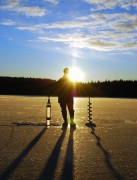 Senare forskning har visat på ett tydligt samband mellan fiskdöd och tofsmygglarver, där ett minskat fiskbestånd kan leda till en explosion av tofsmygglarver i försurade sjöar.
Senare forskning har visat på ett tydligt samband mellan fiskdöd och tofsmygglarver, där ett minskat fiskbestånd kan leda till en explosion av tofsmygglarver i försurade sjöar.
Denna mygginvasion utgör nu grunden till ett unikt forskningsprojekt vid Göteborgs universitet. Genom att undersöka de myggskelett som bevarats i sjöbottnarna, kan forskarna följa hur sjöns fiskbestånd påverkats och förändrats under de senaste århundradena.
– Det vi gör kan faktiskt liknas vid en tidsresa, där vi återskapar en sjös historia från tidigt 1800-tal och framåt. Genom att analysera förekomsten av tofsmyggans käkdelar och fastställa vilka myggarter som förekommer i bottensedimenten kan vi säga om mängden fisk har ökat eller minskat genom historien, om fisken har dött ut helt och försvunnit från sjön, och i grova drag berätta när olika fiskarter dött ut vid svår sjöförsurning, säger Fredrik Palm, doktorand och forskare vid Zoologiska institutionen, Göteborgs universitet.
Undersökningsmetoden gör det möjligt att studera försurningens effekter i sjöar där det inte tidigare skett någon provtagning, och där historiska uppgifter om fisksamhället saknas.
– Sådana studier gör det i sin tur möjligt att bestämma hur en biologisk återställning av en försurad sjö bör gå till, eftersom det avslöjar hur fisksamhället bör se ut om det ska kunna anses vara helt återställt, säger Fredrik Palm.
Metodens historiska perspektiv gör det också möjligt att kartlägga naturliga variationer i en sjös ekosystem. På så sätt kan forskarna se hur mänsklig påverkan som klimatförändringar, övergödning och försurning påverkar sjöarnas ekosystem.
Fredrik Palm genomför sina studier i Västra Götaland och Bohuslän, med speciellt fokus på Gårdsjöområdet i Ucklum, som i många årtionden stått i centrum för svensk försurningsforskning.
Ericssons båda båtar i Volvo Ocean Race har nu tagit in en bra bit av det försprång som Telefonica Blue skaffade sig tidigt under delseglingen till Boston. På tisdagsmorgonen ledde den spanska båten med 61 Nm över Ericsson 4 som låg tvåa och ytterligare 2 Nm till Ericsson 3 på tredje plats. Puma ligger ytterligare 2 Nm bakom Ericsson 3. Det återstår bara knappt 1 800 Nm till etappmålet, så nu gäller det för de övriga båtarna att försöka segla ikapp Telefonica Blue.
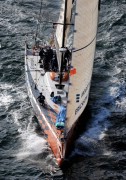 Återhämtningen för det övriga fältet – förutom Telefonica Blue – var på god väg under måndagskvällen. Båtarna från andra plats och nedåt i resultatlistan seglade då betydligt snabbare än den spanska ledningsbåten. Nu återstår att se vem som navigerar rätt i de komplicerade vädersystem som de sju båtarna ska ta sig förbi eller genom.
Återhämtningen för det övriga fältet – förutom Telefonica Blue – var på god väg under måndagskvällen. Båtarna från andra plats och nedåt i resultatlistan seglade då betydligt snabbare än den spanska ledningsbåten. Nu återstår att se vem som navigerar rätt i de komplicerade vädersystem som de sju båtarna ska ta sig förbi eller genom.
Här är den senaste pressreleasen från Race Office:
Leg Six Day 10 Daily Story: Complicated Weather Puts Pressure On Telefónica Blue
Posted: 20 Apr 2009 07:54 AM PDT
The compression has started. Although still leading the fleet, Telefónica Blue has started to sail into a ridge of high pressure, which is checking her progress towards the finish in Boston, and allowing the rest of the fleet a slice of the action.
The compression could last up to 36 hours as the breeze softens ahead and the race from here on in should be a lot closer.
“Hopefully, we have positioned ourselves correctly and we can hang on to our lead,” said Telefónica Blue navigator Tom Addis. “It’s never enjoyable being the lead boat when the fleet is compressing on you, but there is not a lot we can do about it, but we are fine and we are pushing the boat as hard as we can,” he added.
“Now the Weather Gods are smiling in our favour a little bit and pushing Telefónica Blue into lighter air and allowing us to tighten up the gap,” said PUMA’s skipper Kenny Read would dearly like to be on the podium in his home town of Boston.
At 1300 GMT yesterday, Bouwe Bekking and his men had a comfortable lead of 104 nm. Today it is 61nm, and the weather ahead is complicated, making for nervous navigators and skippers.
“The weather models look so horrible that I am contemplating making lots of coffees for the guys, going on deck to help out, check clouds etc. Anything to get me away from the computer and the horrible stuff it is spitting out at me,” said sixth placed Delta Lloyd’s navigator, Wouter Verbraak.
Telefónica Blue is now on the same latitude as the Leeward Islands, while PUMA, Ericsson 3 and Ericsson 4 are in a parallel line with 36 nm between Ericsson 4 in the west and PUMA in the east and all within seven miles of each other.
It is thought that Magnus Olsson, skipper of Ericsson 3, cracked a rib when he was washed into the steering pedestal last week, but according to his crew, he is recovering well.
Today was helmsman Eivind Melleby’s 29th birthday. Part of his surprise was a bag of jelly men sweets, which brought a smile to Olsson’s face when he was handed his share. Melleby said, “The sailing right now is really fun. The team is doing a great job and everybody is enjoying themselves and pushing all the time. Ericsson 3 is a happy ship and goes fast as well.”
In the next tier, just over 40 nm back, are Telefónica Black and Delta Lloyd, followed by Green Dragon a further 22 nm astern. The black boat had an eventful night breaking their gennaker sheet and then having a scare when they collided with a whale. This morning, when daylight broke, the crew checked for damage from the collision and apart from some paint shaved off the forward edge of the keel blade, nothing else was found.
“All onboard love the sea and its animals, and it has been a real shock for everybody to hit one of them,” said skipper Fernando Echávarri.
Current conditions for the fleet are near to perfect, although Wouter Verbraak says that 17 knots of boatspeed just doesn’t have the same adrenaline kick to it. Further ahead, PUMA’s skipper, Kenny Read, is happy.
“This trade wind sailing is a beautiful thing. Just kind of, hook in and hold on, it’s comfortable below and it’s comfortable on deck and we’re ripping along at 20 knots. What is there not to like?” he said.
Phil Jameson from Ericsson 4 says the price paid for such idyllic sailing is being completely soaked, but the water is warm and not many clothes are required. Most of the crew are just wearing very light shorts and short-sleeved shirts under their wet weather gear. “What is nice is coming off watch and just hanging up your foulies and t-shirt and jumping into your bunk with just wet shorts on,” he says.
As the compression intensifies, the blue boat’s speed is down to 14.8 knots, while the black boat is still charging up through the fleet at 20.5 knots. As yesterday, it is PUMA who has the highest 24-hour run, covering 477 nm. No wonder Kenny Read is happy.
Scoring Gate Results Fernando de Noronha
1. Telefónica Blue 19:58:56 GMT 16.04.09 4 Points
2. Ericsson 4 22:55:36 GMT 16.04.09 3.5 Points
3. Delta Lloyd 23:28:32 GMT 16.04.09 3 Points
4. Puma 23:29:31 GMT 16.04.09 2.5 Points
5. Telefónica Black 23:42:20 GMT 16.04.09 2 Points
6. Ericsson 3 00:14:28 GMT 17.04.09 1.5 Points
7. Green Dragon 01:27:26 GMT 17.04.09 1 Point
Leg Six Day 10: 1300 GMT Volvo Ocean Race Positions
(boat name/country/skipper/nationality/distance to finish)
1. Telefónica Blue ESP (Bouwe Bekking/NED) DTF 2,027 nm
2. Ericsson 3 SWE (Magnus Olsson/SWE) +61 nm
3. PUMA Racing Team USA (Ken Read/USA) +61 nm
4. Ericsson 4 SWE (Torben Grael/BRA) +67 nm
5. Telefónica Black ESP (Fernando Echávarri/ESP) +100 nm
6. Delta Lloyd IRL (Roberto Bermúdez/ESP) +109 nm
7. Green Dragon IRL/CHN (Ian Walker/GBR) +131 nm
8. Team Russia RUS (Andreas Hanakamp/AUT) DNS
Mer än 38 miljoner ton eller 40 procent av all fisk som världens fiskeflottor fångar varje år tas inte tillvara, visar en ny vetenskaplig studie av WWF. – Att låta miljontals ton fisk gå till spillo varje år är miljömässigt förkastligt och borde vara ekonomiskt oförsvarbart, säger Lasse Gustavsson, generalsekreterare på Världsnaturfonden WWF. Med så höga bifångster som 40 procent blir det omöjligt att bedriva ett långsiktigt hållbart fiske.
Den viktigaste orsaken till de höga bifångsterna är att den stora majoriteten av de fiskeredskap som idag används av fiskeflottorna inte är selektiva, utan de fångar även stora mängder “oönskad” fångst utöver den art man egentligen vill ha.
Genom att omdefiniera begreppet bifångst som något fiskare tar från våra hav och som är “outnyttjat” så överträffar studien tidigare uppskattningar av global bifångst, som huvudsakligen fokuserat på fångst som kastats över bord och som varierat mellan 7-27 miljoner ton per år. De ska alltså jämföras med de nya bifångstsiffrorna på 38 miljoner ton.
– I många fall kastas fisk och andra marina djur tillbaka döda eller döende i havet och även om bifångsten tas tillvara så finns det inget sätt att veta om det var hållbart att plocka dessa arter ur havet. Bifångst är en lömsk och osynlig form av överfiske, menar Inger Näslund, fiskeansvarig på Världsnaturfonden WWF.
I Nordost-Atlanten kastas en femtedel av områdets sammanlagda marina fångst överbord, enligt studien. Den mest slösaktiga formen av fiske är troligtvis hajfensfiske där uppskattningsvis 92 procent av fångsten inklusive de döende, fenlösa hajarna kastas tillbaka.
För att försöka lösa de svåra problemen med bifångster har WWF för fjärde året utlyst tävlingen Smart Gear där det gäller att ta fram smarta fiskeredskap som minskar just bifångster. Tävlingsbidragen ska vara inlämnade senast 30 juni i år.
– Bifångster är ett allvarligt hot mot djurlivet i våra hav och Smart Gear har visat sig effektiv när det gäller att få kreativa tänkare att utveckla nya fiskeredskap som yrkesfiskare sedan kan använda för att fiska mer uthålligt, säger Inger Näslund. Förra årets vinnare var ett lag med amerikanska uppfinnare från Rhode Island som utvecklade ett redskap för fiske av kolja samtidigt som man minskade risken att fånga andra arter, exempelvis torsk.
WWF anser att all form av fiske måste ske på ett långsiktigt hållbart sätt baserat på friska ekosystem. Arbetet med att utveckla EUs gemensamma fiskeripolitik i den riktningen är ett måste och här har Sveriges regering under sitt ordförandeskap 2009 en viktig roll för att sätta agendan i rätt riktning. Konsumenter, handel och fiskproducenter kan stödja ett hållbart fiske genom att välja produkter från områden som förvaltas mer uthålligt.
Länk: www.wwf.se/smartgear
Kommentarer
Som yrkes fiskare håller jag med att kasta fisk är inget jag gilar men så som läget ser ut i dag så är vi tvugna rfter som det kvot system som fins förutsätter att vi vet precis hur mycket vi får upp i förväg.
Om kvot systemet hadde varit mera flexibelt och tillåtit att över fångst fåtts ta iland (varit med om flera gånger att vi fått kasta 2 – 3 ton på grund av oväntat stor fångst i sista draget) och istället minskat kvoten för nästa vecka i stället för att kraftigt bötfälla oss för något som vi inte kan kontrolera.
har man i 7 dagar fått 10 låder i draget så väntar man sig inte att plötsligt få 300 i sista på samma ställe
Greenpeace flaggskepp Rainbow Warrior har inlett en dykexpedition till utsjöbankarna Fladen och Lilla Middelgrund i Kattegatt utanför Hallandskusten. Fram till den 21 april kommer flora och fauna samt eventuella skador på miljön i de två Natura 2000-områdena att dokumenteras av dykare och med undervattenskamera, s k drop cam. Expeditionen är en del i förberedelserna inför den utplacering av trålhinder i form av stora granitblock som Greenpeace planerar att genomföra i månadsskiftet augusti – september.
– Syftet med expeditionen är att undersöka de förekomster av känsliga och värdefulla miljöer som tidigare dokumenterats av forskare och myndigheter inför utplaceringen av trålhinder i områdena, säger Isadora Wronski, kampanjledare ombord på Rainbow Warrior.
Fladen och Lilla Middelgrund, som ligger ungefär 20 km utanför Varberg, ingår i det nätverk av Natura 2000-områden med känsliga miljöer som EU:s medlemsstater enligt habitatdirektivet är skyldiga att skydda från förstörelse. Sverige har enligt direktivet sex år på sig att införa skyddsåtgärder, annars bryter landet mot EU-lagstiftningen. Ytterst är det regeringen som bär ansvaret. Men trots att bottentrålning har identifierats av länsstyrelsen i Halland som ett hot mot flora och fauna är det fortfarande fritt fram att tråla överallt på utsjöbankarna.
Efter decennier av destruktivt fiske, föroreningar, grusutvinning och andra skadliga mänskliga aktiviteter hör Fladen och Lilla Middelgrund till de få europeiska havsområden som fortfarande har en stor biologisk mångfald.
– Ansvariga politiker har inte bara en juridisk skyldighet att stoppa förödelsen. Områdena är också viktiga för hela Kattegatts överlevnad. Det gör skyddet av de här och andra biologiskt viktiga områden till en moralisk skyldighet gentemot kommande generationer, säger Isadora Wronski.
Marina reservat, i ekonomisk zon, saknar idag i praktiken skydd från destruktivt fiske eftersom EU:s regler ger väldigt begränsade möjligheter för nationella myndigheter i medlemsländerna att reglera fisket i sina vatten.
Grundproblemet är att fisket lyder under fiskelagstiftning och havsmiljön under miljölagstiftningen. Det gör att lag står mot lag. Och idag är det alltid miljön som får ge efter för kortsiktiga fiskeintressen. Under Sveriges ordförandeskap i EU har regeringen en unik möjlighet att starta den reform av EU:s gemensamma fiskeripolitik som måste till för att lösa konflikten. Havsförvaltningen måste utgå från ekosystemansatsen, vilket innebär att även fiskbestånden ses som en del av ekosystemen. Ansvaret för just EU:s havsfrågor tog Sverige över redan vid årsskiftet.
– Krångliga regler är ingen ursäkt för att sitta med armarna i kors medan våra hav dör. Regeringen måste försöka, men hittills har inget gjorts, säger Isadora Wronski.

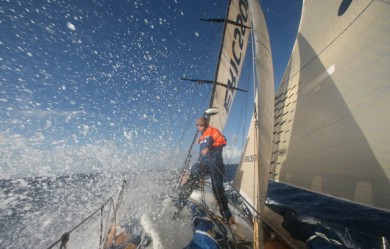
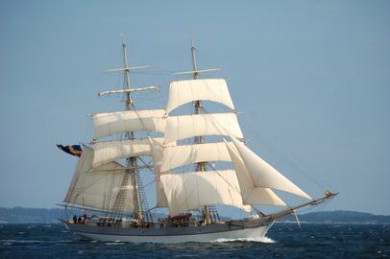
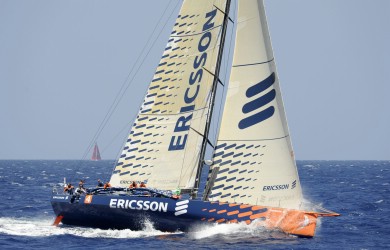

.jpg)
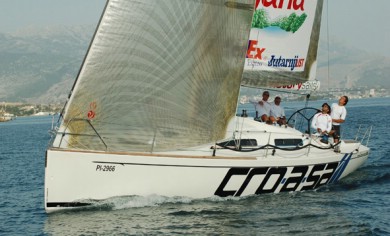
.jpg)
.jpg)
.jpg)

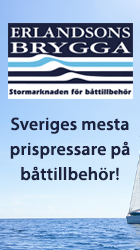
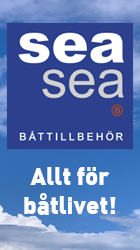
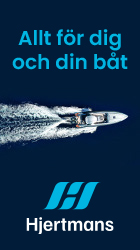

Kommentarer
Har strand Craft nånsin sålt nått?
Jodå. Några mindre och bl.a den här. Men jag tror bolaget är konkat nu
Ligger på rastaholms varv ekerö.
Helt otäkt.
9 miljoner o otäkt?
Helt galet tycker jag
Var det inte den här båten som låg till salu på Öppna Varv på Orust?
Såldes väl på Kvarndammen…
Ligger en i Minnerbergs båtklubb
SSS Traneberg…